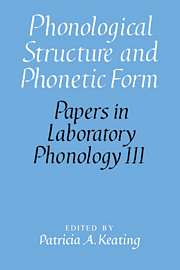Book contents
- Frontmatter
- Contents
- List of contributors
- Acknowledgments
- 1 Introduction
- I Intonation
- 2 Articulatory evidence for differentiating stress categories
- 3 “Stress shift” as early placement of pitch accents: a comment on Beckman and Edwards
- 4 Constraints on the gradient variability of pitch range, or, Pitch level 4 lives!
- 5 “Gesture” in prosody: comments on the paper by Ladd
- 6 What is the smallest prosodic domain?
- 7 The segment as smallest prosodic element: a curious hypothesis
- II Syllables
- III Feature Theory
- IV Phonetic Output
- Index of subjects
- Index of names
3 - “Stress shift” as early placement of pitch accents: a comment on Beckman and Edwards
Published online by Cambridge University Press: 26 February 2010
- Frontmatter
- Contents
- List of contributors
- Acknowledgments
- 1 Introduction
- I Intonation
- 2 Articulatory evidence for differentiating stress categories
- 3 “Stress shift” as early placement of pitch accents: a comment on Beckman and Edwards
- 4 Constraints on the gradient variability of pitch range, or, Pitch level 4 lives!
- 5 “Gesture” in prosody: comments on the paper by Ladd
- 6 What is the smallest prosodic domain?
- 7 The segment as smallest prosodic element: a curious hypothesis
- II Syllables
- III Feature Theory
- IV Phonetic Output
- Index of subjects
- Index of names
Summary
Beckman and Edwards' paper has two parts: a concise synthesis of an emerging phonological view of prosodic structure, in which the prominent element or head at each level of the prosodic constituent hierarchy is cued by a level-specific set of phonological and phonetic variables, and a description of an experiment aimed at clarifying the articulatory correlates of the levelspecific contrasts in stress described in the theory. I will focus here, briefly, on the phonological model and, more extensively, its account of perceived stress shift in terms of the placement of phrase-level pitch accents.
A model of stress
Beckman and Edwards (henceforth B & E) see prosody as a mechanism for organizing utterances, and “stress” as a term for a number of different types of prominence. They concentrate on two kinds of prominence contrast, presence/absence of a nuclear pitch accent, and presence/absence of a full vowel. Each type of prominence corresponds to the head of a different constituent level in the prosodic hierarchy:
the nuclear-pitch-accented syllable (the last and strongest prominence in the constituent “intermediate phrase”) versus
the non-pitch-accented full-vowel syllable (the first and strongest prominence in the constituent “stress foot”) versus
the reduced syllable (a nonhead element in the stress foot).
A fourth type of generally recognized prominence, the prenuclear accented syllable, is not included in the discussion of the model but is mentioned by B & E.
- Type
- Chapter
- Information
- Phonological Structure and Phonetic Form , pp. 34 - 42Publisher: Cambridge University PressPrint publication year: 1994



